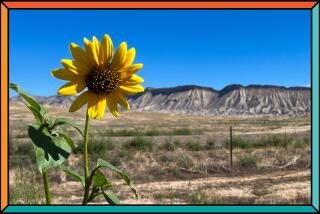Feathery exotics
The classic trees of California are big. Redwoods. Monterey pines. Valley oaks. So, for those of us who live in cities but want a California native garden, whereâs the giant sequoia supposed to fit?
My vote would be to tear down the house, but San Juan Capistrano nurseryman Mike Evans has a different idea. The man who for two decades has been a pillar of the native gardening community thinks that many Southern Californian homes with small gardens can be better off with exotic trees.
Evans, co-founder of the Tree of Life Nursery, is increasingly pointing his customers toward the leguminous trees of Mexico, Arizona and Texas. Heâs even giving free classes in how to use these trees, which are members of the pea family.
âI am convinced that theyâre perfect for patio situations,â he said in a recent class. âThey donât get too big. Youâre talking about a wide range of plants that are diverse, easy to grow and that give back by flowering their heads off through the summer.â
To this he could add that hummingbirds love them.
There are those who think that straying southeast of the California state line is a bad thing, a sin even. However, Evans argues not in terms of the political boundaries but of regional floristic provinces defined by which plants grow where. To him, although the Sonoran classics of palo verde, ironwood and mesquite arenât necessarily native, they fit better in Southern California than conifers from the rain forests of Monterey or the oaks from the fog-cloaked dales of Marin County.
In common with many of our natives and their sister plants from Mediterranean climate zones around the world, these leguminous trees of the Sonoran Desert tend to be nitrogen-fixing, meaning they absorb nitrogen from the air and sequester it in the soil. That ability allows them to thrive in poor soils, so donât fertilize them. This is a particularly common trait among leguminous plants, so also expect pods from them.
The Sonoran natives being tested by Evans and then sold through these classes differ from California natives in one basic way. Their natural ranges lie at the confluence of desert and tropical climate zones, so they evolved getting winter rain as well as monsoonal summer showers. This means they can adapt to a setting with some summer water.
Sometimes, they can adapt too well. The University of Arizonaâs Cooperative Extension warns against plants from the genus Parkinsonia, known commonly as Mexican palo verde, on the grounds that itâs invasive. But if you fall in love with the graceful habit and showy yellow flowers, look for the hybrid called Desert Museum, or simply hop around the leguminous family tree until you get to blue palo verde, which is from a different genus and species entirely (Cercidium floridum). This looks so pretty year-round that a crown of yellow blooms in early spring is pure gravy.
Of all these plants, the Baja fairy duster ( Calliandra californica and Calliandra peninsularis ) is increasingly being adopted in Los Angeles. Itâs more of a shrub, but if 6 feet is as tall as you want in a patio tree, then all you need is a good pair of hand pruners.
One outlier among these largely feathery plants, because of its shiny evergreen leaves and a definite contender for tree status, is the 25-foot-tall Texas mountain laurel (Sophora secundiflora). Texas horticulturist William Welch describes the wanton drop of spring flowers as âbeautiful purple, wisteria-like blooms smelling of grape Kool-Aid.â
From the genus of the most classic Southwestern plant, mesquite, Evans is working with Prosopis glandulosa, or honey mesquite. Needless to say, but I will anyway, bees love it.
At Tree of Life, Evans has planted a desert fern (Lysiloma thornberi). Commonly called feather bush, this plant doesnât need the puff ball white flowers it produces each spring in Evansâ courtyard to explain why he chose it. Its fingered leaves are masters of sunlight. Rather than block it, they hold it in a dancing, luminous cloud -- quite a feat amid the glare.
To track Evansâ workshops in gardening with leguminous trees of the Sonoran Desert and Baja, click to www.califor nianativeplants.com. Recommended reading: The Arizona-Sonora Desert Museumâs âA Natural History of the Sonoran Desert,â edited by Steven J. Phillips and Patricia Wentworth Comus.
--
Greenâs column on drought-tolerant gardening appears weekly on our L.A. at Home blog, latimes.com/com. She also writes on water issues at www.chanceofrain.com.






